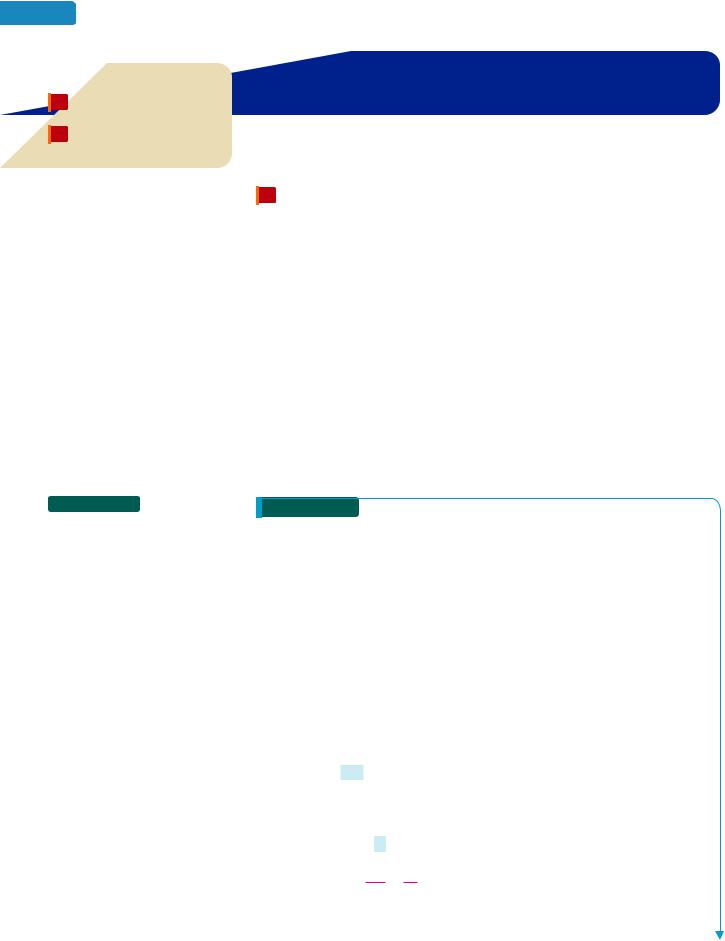
- •Study Skills Workshop
- •1.1 An Introduction to the Whole Numbers
- •1.2 Adding Whole Numbers
- •1.3 Subtracting Whole Numbers
- •1.4 Multiplying Whole Numbers
- •1.5 Dividing Whole Numbers
- •1.6 Problem Solving
- •1.7 Prime Factors and Exponents
- •1.8 The Least Common Multiple and the Greatest Common Factor
- •1.9 Order of Operations
- •THINK IT THROUGH Education Pays
- •2.1 An Introduction to the Integers
- •THINK IT THROUGH Credit Card Debt
- •2.2 Adding Integers
- •THINK IT THROUGH Cash Flow
- •2.3 Subtracting Integers
- •2.4 Multiplying Integers
- •2.5 Dividing Integers
- •2.6 Order of Operations and Estimation
- •Cumulative Review
- •3.1 An Introduction to Fractions
- •3.2 Multiplying Fractions
- •3.3 Dividing Fractions
- •3.4 Adding and Subtracting Fractions
- •THINK IT THROUGH Budgets
- •3.5 Multiplying and Dividing Mixed Numbers
- •3.6 Adding and Subtracting Mixed Numbers
- •THINK IT THROUGH
- •3.7 Order of Operations and Complex Fractions
- •Cumulative Review
- •4.1 An Introduction to Decimals
- •4.2 Adding and Subtracting Decimals
- •4.3 Multiplying Decimals
- •THINK IT THROUGH Overtime
- •4.4 Dividing Decimals
- •THINK IT THROUGH GPA
- •4.5 Fractions and Decimals
- •4.6 Square Roots
- •Cumulative Review
- •5.1 Ratios
- •5.2 Proportions
- •5.3 American Units of Measurement
- •5.4 Metric Units of Measurement
- •5.5 Converting between American and Metric Units
- •Cumulative Review
- •6.2 Solving Percent Problems Using Percent Equations and Proportions
- •6.3 Applications of Percent
- •6.4 Estimation with Percent
- •6.5 Interest
- •Cumulative Review
- •7.1 Reading Graphs and Tables
- •THINK IT THROUGH The Value of an Education
- •Cumulative Review
- •8.1 The Language of Algebra
- •8.2 Simplifying Algebraic Expressions
- •8.3 Solving Equations Using Properties of Equality
- •8.4 More about Solving Equations
- •8.5 Using Equations to Solve Application Problems
- •8.6 Multiplication Rules for Exponents
- •Cumulative Review
- •9.1 Basic Geometric Figures; Angles
- •9.2 Parallel and Perpendicular Lines
- •9.3 Triangles
- •9.4 The Pythagorean Theorem
- •9.5 Congruent Triangles and Similar Triangles
- •9.6 Quadrilaterals and Other Polygons
- •9.7 Perimeters and Areas of Polygons
- •THINK IT THROUGH Dorm Rooms
- •9.8 Circles
- •9.9 Volume
- •Cumulative Review

|
Objectives |
S E C T I O N 8.4 |
|
|
|
1 |
Use more than one property of |
More about Solving Equations |
|
|
|
equality to solve equations. |
|
|
2 |
|
|
||
Simplify expressions to solve |
We have solved simple equations by using properties of equality. We will now expand |
|||
668 |
Chapter 8 An Introduction to Algebra |
|||
equations.
our equation-solving skills by considering more complicated equations.
 Self Check 1
Self Check 1
Solve: 8x 13 43
Now Try Problem 15
1 Use more than one property of equality to solve equations.
Sometimes we must use several properties of equality to solve an equation. For example, on the left side of 2x 6 10, the variable x is multiplied by 2, and then 6 is added to that product. To isolate x, we use the order of operations rules in reverse. First, we undo the addition of 6, and then we undo the multiplication by 2.
2x 6 |
10 |
This is the equation to solve. |
|||
2x 6 6 |
10 6 |
To undo the addition of 6, subtract 6 from both sides. |
|||
|
2x |
4 |
|
Do the subtractions. |
|
|
2x |
4 |
|
To undo the multiplication by 2, divide both sides by 2. |
|
|
|
|
|
|
|
2 |
2 |
|
|||
|
x |
2 |
|
On the left side, simplify by removing the common |
|
|
|
|
|
|
factor of 2 from the numerator and denominator: |
|
|
|
|
|
1 |
2x x. On the right side, do the division.
2
1
The solution is 2.
EXAMPLE 1 |
Solve: 12x 5 |
17 |
|
Strategy First we will use a property of equality to isolate the variable term on one side of the equation. Then we will use a second property of equality to isolate the variable itself.
WHY To solve the original equation, we want to find a simpler equivalent equation of the form x a number, whose solution is obvious.
Solution
On the left side of the equation, x is multiplied by 12, and then 5 is added to that product. To isolate x, we undo the operations in the opposite order.
•To isolate the variable term, 12x, we subtract 5 from both sides to undo the addition of 5.
•To isolate the variable, x, we divide both sides by 12 to undo the multiplication by 12.
12x 5 17
12x 5 5 17 5
12 x 12
12x 12
12 12
This is the equation to solve. First, we want to isolate the variable term, 12x.
Use the subtraction property of equality: Subtract 5 from both sides to isolate 12x.
Do the subtractions: 5 5 0 and 17 5 12.
Now we want to isolate the variable, x.
Use the division property of equality: Divide both sides by 12 to isolate x.
1
On the left side simplify: |
12x x. |
x 1 |
12 |
1 |
On the right side, do the division.

8.4 More about Solving Equations |
669 |
Check: |
12x 5 17 |
This is the original equation. |
|
|
12(1) 5 |
17 |
Substitute 1 for x . |
|
12 5 |
17 |
Do the multiplication on the left side. |
|
17 |
17 |
True |
The solution is 1.
Caution! When checking solutions, always use the original equation.
The Language of Algebra In Example 1, we subtract 5 from both sides to isolate the variable term, 12x. Then we divide both sides by 12 to isolate the variable, x.
EXAMPLE 2 Solve: 10 5s 60
Strategy First we will use a property of equality to isolate the variable term on one side of the equation. Then we will use a second property of equality to isolate the variable itself.
WHY To solve the original equation, we want to find a simpler equivalent equation of the form a number s, whose solution is obvious.
Solution
On the right side of the equation, 5 is multiplied by 5, and then 60 is subtracted from that product. To isolate s, we undo the operations in the opposite order.
•To isolate the variable term, 5s, we add 60 to both sides to undo the subtraction of 60.
•To isolate the variable, s, we divide both sides by 5 to undo the multiplication by 5.
10 5s 60
10 60 5s 60 60
70 5 s
70 5s
5 5
14 s
This is the equation to solve. First, we want to isolate the variable term, 5s.
Use the addition property of equality: Add 60 to both sides to isolate 5s.
Do the additions: 10 60 70 and 60 60 0.
Now we want to isolate the variable, s.
Use the division property of equality: |
|
|
14 |
|
Divide both sides by 5 to isolate s. |
|
|
5 |
70 |
On the left side, do the division. The quotient |
|
|
5 |
|
|
|
20 |
||
of a positive and a negative number is negative. |
|
|
||
|
|
20 |
||
1 |
|
|
||
5s |
|
|
0 |
|
On the right side, simplify: 5 s. |
|
|
||
|
||||
|
|
1 |
|
|
Check: 10 |
5s 60 |
This is the original equation. |
|
2 |
|
||||
|
14 |
|||
10 |
5( 14) 60 |
Substitute 14 for s. |
|
5 |
10 |
70 60 |
Do the multiplication on the right side. |
|
70 |
|
|
|||
10 |
10 |
True |
|
|
The solution is –14.
 Self Check 2
Self Check 2
Solve: 40 4d 8
Now Try Problem 25

670 |
Chapter 8 An Introduction to Algebra |
 Self Check 3
Self Check 3
Solve: 127 a 6 27
Now Try Problem 29
 Self Check 4
Self Check 4
Solve: 6.6 m 2.7
Now Try Problem 35
|
EXAMPLE 3 |
5 |
|
|
Solve: |
m 2 12 |
|
|
8 |
||
|
|
|
Strategy We will use properties of equality to isolate the variable on one side of the equation.
WHY To solve the original equation, we want to find a simpler equivalent equation of the form m a number, whose solution is obvious.
Solution
We note that the coefficient of m is 58 and proceed as follows.
•To isolate the variable term 58 m, we add 2 to both sides to undo the subtraction of 2.
•To isolate the variable, m, we multiply both sides by 85 to undo the multiplication by 58 .
5
8 m 2 12
58 m 2 2 12 2
58 m 10
85 a58 mb 85 ( 10)
m 16
This is the equation to solve.
5
First, we want to isolate the variable term, 8 m.
Use the addition property of equality: Add 2 to both sides to isolate 85 m.
Do the additions: 2 2 0 and 12 2 10.
Now we want to isolate the variable, m.
Use the multiplication property of equality: |
||||
Multiply both sides by 85 |
1which is the |
|||
reciprocal of 85 2to isolate m. |
|
|||
On the left side: 8 |
15 2 1 and 1m m. On the |
|||
5 |
8 |
|
1 |
|
8 |
|
8 2 5 |
|
|
right side: 5 ( 10) |
|
|
|
16. |
|
5 |
|||
|
|
|
1 |
|
The solution is 16. Check by substituting it into the original equation.
EXAMPLE 4 Solve: 0.2 0.8 y
Strategy First, we will use a property of equality to isolate the variable term on one side of the equation. Then we will use a second property of equality to isolate the variable itself.
WHY To solve the original equation, we want to find a simpler equivalent equation of the form a number y, whose solution is obvious.
Solution
To isolate the variable term y on the right side, we eliminate 0.8 by adding 0.8 to both sides.
0.2 0.8 y
0.2 0.8 0.8 y 0.8
0.6 y
This is the equation to solve. First, we want to isolate the variable term, y.
Add 0.8 to both sides to isolate y.
Do the additions.
0.8
0.2
0.6
Since the term y has an understood coefficient of 1, the equation can be written as 0.6 1y. To isolate y, we can either multiply both sides or divide both sides by 1. If we choose to divide both sides by 1, we proceed as follows.
0.61 y Now we want to isolate the variable y.
0.61y On the left side, do the division. The quotient of a positive and a negative
|
|
|
|
|
1 |
|
1 1 |
number is negative. On the right side, simplify: |
1y |
y. |
|||
1 |
||||||
0.6 y |
|
1 |
|
|||
|
|
|
||||
The solution is 0.6. Check this by substituting it into the original equation.

8.4 More about Solving Equations |
671 |
2 Simplify expressions to solve equations.
When solving equations, we should simplify the expressions that make up the left and right sides before applying any properties of equality. Often, that involves removing parentheses and/or combining like terms.
EXAMPLE 5 Solve: a. 3(k 1) 5k 0 b. 8a 2(a 7) 68
Strategy We will use the distributive property along with the process of combining like terms to simplify the left side of each equation.
WHY It’s best to simplify each side of an equation before using a property of equality.
Solution
|
|
a. 3(k 1) 5k 0 3k 3 5k 0
2k 3 0
2k 3 3 0 3
2k 3
2k 3
2 2
k
3
2
This is the equation to solve.
Distribute the multiplication by 3.
Combine like terms: 3k 5k 2k.
First, we want to isolate the variable term, 2k.
To undo the addition of 3, subtract 3 from both sides. This isolates 2k.
Do the subtractions: 3 3 0 and 0 3 3.
Now we want to isolate the variable, k.
To undo the multiplication by 2, divide both sides by 2. This isolates k.
3 3
On the right side, simplify: 2 2 .
Check: 3(k 1) 5k 0 3a32 1b 5a32b 0 3a52 b 5a32 b 0 152 152 0 0 0
The solution is 32 .
This is the original equation.
Substitute 32 for k.
Do the addition within the parentheses. Think of 1 as 22 and then add: 32 22 52 .
Do the multiplications.
True
Caution! To check a result, we evaluate each side of the equation following the order of operations rule. For the check shown above, perform the addition within parentheses first. Don’t distribute the multiplication by 3.
3a2 1b |
|
|
|
|||||
|
|
3 |
|
|
|
|
|
|
|
⎪ ⎨ ⎪ ⎩ |
|
|
|
||||
|
Add first |
|
|
|
||||
|
|
|
This is the equation to solve. |
|
|
|||
b. 8a 2(a 7) 68 |
|
|
||||||
8a 2a 14 |
68 |
Distribute the multiplication by 2. |
|
|
||||
|
|
14 |
68 |
|
|
|
||
|
6a |
Combine like terms: 8a 2a 6a. First, |
|
|
||||
|
|
|
|
|
|
we want to isolate the variable term, 6a. |
|
68 |
|
|
|
|
|
|
|
||
|
|
|
|
|
|
|
|
|
6a 14 14 |
68 14 |
To undo the addition of 14, subtract 14 from |
|
14 |
||||
both sides. This isolates 6a. |
|
54 |
||||||
|
|
|
|
|
|
|
||
 Self Check 5
Self Check 5
Solve:
a.4(a 2) a 11
b.9x 5(x 9) 1
Now Try Problems 39 and 45

672 |
Chapter 8 An Introduction to Algebra |
6 |
|
|
54 |
Do the subtractions. Now we want to isolate the variable, a. |
|||
a |
|||||||
6a |
54 |
To undo the multiplication by 6, divide both sides by 6. |
|||||
|
|
|
This isolates a. |
|
|
||
6 |
6 |
|
|
||||
|
|
|
|
|
|
1 |
|
|
|
|
|
|
On the left side, simplify: |
6a |
a . |
|
a |
9 |
|
6 |
|
||
|
|
1 |
|
||||
On the right side, do the division.
The solution is 9. Use a check to verify this.
 Self Check 6
Self Check 6
Solve: 30 6n 4n 2
Now Try Problem 57
 Self Check 7
Self Check 7
Solve:
6(5x – 30) – 2x = 8(x + 50)
Now Try Problem 59
When solving an equation, if variables appear on both sides, we can use the addition (or subtraction) property of equality to get all variable terms on one side and all constant terms on the other.
EXAMPLE 6 Solve: 3x 15 4x 36
Strategy There are variable terms (3x and 4x) on both sides of the equation. We will eliminate 3x from the left side of the equation by subtracting 3x from both sides.
WHY To solve for x, all the terms containing x must be on the same side of the equation.
Solution
3x 15 4x 36
3x 15 3x 4x 36 3x
15 x 36
15 36 x 36 36
51 x
This is the equation to solve. There are variable terms on both sides of the equation.
Subtract 3x from both sides to isolate the variable term on the right side.
Combine like terms: 3x 3x 0 and 4x 3x x.
Now we want to isolate the variable, x.
To undo the addition of 36, subtract |
1 |
|
15 |
||
36 from both sides. This isolates x. |
||
36 |
||
|
||
Do the subtractions. |
51 |
Check: |
3x 15 4x 36 |
This is the original equation. |
|
|
3( 51) 15 |
4( 51) 36 |
Substitute 51 for x. |
|
153 15 |
204 36 |
Do the multiplications. |
|
168 |
168 |
True |
The solution is 51.
51 |
51 |
|
3 |
4 |
|
153 |
204 |
|
|
9 |
|
153 |
1 1014 |
|
20 4 |
|
|
15 |
36 |
|
168 |
168 |
|
|
|
|
|
|
|
Success Tip In Example 6, we could have eliminated 4x from the right side by subtracting 4x from both sides:
3x 15 4x 4x 36 4x
x 15 36 Note that the coefficient of x is negative.
However, it is usually easier to isolate the variable term on the side that will result in a positive coefficient.
EXAMPLE 7 Solve: 3(4x 80) 6x 2(x 40)
Strategy We will use the distributive property on each side of the equation to remove the parentheses. Then we will combine any like terms.
WHY It is easiest to simplify the expressions that make up the left and right sides of the equation before using the properties of equality to isolate the variable.

8.4 More about Solving Equations |
673 |
Solution
3(4x 80) 6x 2(x 40) 12x 240 6x 2x 80
18x 240 2x 80
This is the equation to solve.
Distribute the multiplication by 3 and by 2.
On the left side, combine like terms: 12x 6x 18x. There are variable terms on both sides.
18x 240 2x 2x 80 2x
To eliminate the term 2x on the right side, subtract 2x from both sides.
16x 240 80
16x 240 240 80 240
16x 320
16x 320
16 16
x 20
Combine like terms on each side: 18x 2x 16x and 2x 2x 0.
To isolate the variable term, 16x, on the left side, add 240 to both sides to undo the subtraction of 240.
Do the addition on each side:
240 240 0 and 80 240 320.
Now we want to isolate the variable, x.
To isolate x on the left side, divide both sides by 16 to undo the multiplication by 16.
1
On the left side, simplify, 1616x x.
1
On the right side, do the division.
1
24080 320
20
16 320
32
00
0
0
The solution is 20. Check by substituting it in the original equation.
The previous examples suggest the following strategy for solving equations. You won’t always have to use all four steps to solve a given equation. If a step doesn’t apply, skip it and go to the next step.
Stategy for Solving Equations
1.Simplify each side of the equation: Use the distributive property to remove parentheses, and then combine like terms on each side.
2.Isolate the variable term on one side: Add (or subtract) to get the variable term on one side of the equation and a number on the other using the addition (or subtraction) property of equality.
3.Isolate the variable: Multiply (or divide) to isolate the variable using the multiplication (or division) property of equality.
4.Check the result: Substitute the possible solution for the variable in the original equation to see if a true statement results.
ANSWERS TO SELF CHECKS
1. 7 2. 12 3. 36 4. 3.9 5. a. 1 b. 11 6. 16 7. 29
 S E C T I O N 8.4 STUDY SET
S E C T I O N 8.4 STUDY SET
VOCABULARY
Fill in the blanks.
1. To an equation means to find all values of the
variable that make the equation true.
2. |
The equation 6x 3 4x 1 has variable terms on |
|||
|
|
sides. |
|
|
3. |
When solving equations, |
|
the expressions that |
|
|
make up the left and right sides of the equation before |
|||
|
using the properties of equality to isolate the variable. |
|||

674Chapter 8 An Introduction to Algebra
4.When we write the expression 9x x as 10x, we say
we have |
|
like terms. |
CONCEPTS
5.On the left side of the equation 4x 9 25, the variable x is multiplied by  , and then
, and then  is added to that product.
is added to that product.
6.On the right side of the equation 16 5t 1, the variable t is multiplied by  , and then
, and then  is subtracted from that product.
is subtracted from that product.
Fill in the blanks. |
|
|
|||||
7. |
To solve 3x 5 1, we first undo the |
|
|
of |
|||
|
5 by adding 5 to both sides. Then we undo the |
|
|
||||
|
|
by 3 by dividing both sides by 3. |
|
|
|||
8. |
To solve 2x 3 5, we can undo the |
|
|
|
of 3 by |
||
|
|
||||||
|
subtracting 3 from both sides. Then we can undo the |
||||||
by 2 by multiplying both sides by 2.
9.a. Combine like terms on the left side of 6x 8 8x 24.
b.Distribute and then combine like terms on the right side of 20 4(3x 4) 9x.
10.Distribute on both sides of the equation shown below. Do not solve.
7(3x 2) 4(x 3)
11.Use a check to determine whether 2 is a solution of the equation.
a. 6x 5 7 |
b. 8(x 3) 8 |
12.a. Simplify: 3x 5 x
b.Solve: 3x 5 9
c.Evaluate 3x 5 x for x 9.
d.Check: Is 1 a solution of 3x 5 x 9?
NOTATION
Complete the solution.
13. Solve: |
2x 7 21 |
|
||||||||
|
2x 7 |
|
21 |
|
||||||
|
|
|
||||||||
|
|
2x 28 |
|
|||||||
|
|
2x |
|
|
28 |
|
|
|
||
|
|
|
|
|
|
|
|
|
||
|
|
|
|
|
|
|
|
|
|
|
|
|
|
x 14 |
|
||||||
Check: |
2x 7 21 |
|
||||||||
2( ) 7
) 7 21
21
 7 21
7 21  21
21
 is the solution.
is the solution.
14. Fill in the blank: y  y
y
GUIDED PRACTICE
Solve each equation and check the result. See Example 1.
15. |
2x 5 17 |
16. |
4p 3 43 |
17. |
5q 2 23 |
18. |
3x 5 13 |
19. |
33 5t 2 |
20. |
55 3w 5 |
21. |
0.7 4y 1.7 |
22. |
0.3 2x 0.9 |
23. |
5 2d 0 |
24. |
8 3c 0 |
Solve each equation and check the result. See Example 2.
25. |
12 7a 9 |
26. |
15 8b 1 |
27. |
3 3p 7 |
28. |
1 2r 8 |
Solve each equation and check the result. See Example 3.
29. |
2 |
t 2 6 |
30. |
3 |
x 6 12 |
|||||
3 |
5 |
|||||||||
|
|
|
|
|
|
|
|
|||
31. |
5 |
k 5 10 |
32. |
2 |
c 12 2 |
|||||
6 |
5 |
|||||||||
|
|
|
|
|
|
|
|
|||
33. |
|
7 |
h 28 21 |
34. |
|
5 |
h 25 15 |
|||
16 |
|
|||||||||
|
|
|
|
|
8 |
|
||||
Solve each equation and check the result. See Example 4.
35. |
1.7 1.2 x |
36. |
0.6 4.1 x |
37. |
6 y 2 |
38. |
1 h 9 |
Solve each equation and check the result. See Example 5.
39.3(2y 2) y 5
40.2( 3a 2) a 2
41.9(x 11) 5(13 x) 0
42.20b 2(6b 1) 34
43.(4 m) 10
44.(6 t) 12
45.10.08 4(0.5x 2.5)
46.3.28 8(1.5y 0.5)
47.6a 3(3a 4) 30
48.16y 8(3y 2) 24
49.(19 3s) (8s 1) 35
50.6x 5(3x 1) 58
Solve each equation and check the result. See Example 6.
51. |
5x 4x |
|
7 |
52. |
3x |
2x 2 |
53. |
8y 44 |
|
4y |
54. |
9y |
36 6y |
55. |
60r 50 15r 5 |
56. |
100ƒ 75 50ƒ 75 |
|||
57. |
8y 2 4y 16 |
58. |
7 3w 4 9w |
|||
Solve each equation and check the result. See Example 7.
59.3(A 2) 4A 2(A 7)
60.9(T 1) 18T 6(T 2)
61.2 3(x 5) 4(x 1)
62.2 (4x 7) 3 2(x 2)
TRY IT YOURSELF
Solve each equation. Check the result.
63.3x 8 4x 7x 2 8
64.6t 7t 5t 1 12 3
65.4(d 5) 20 5 2d
